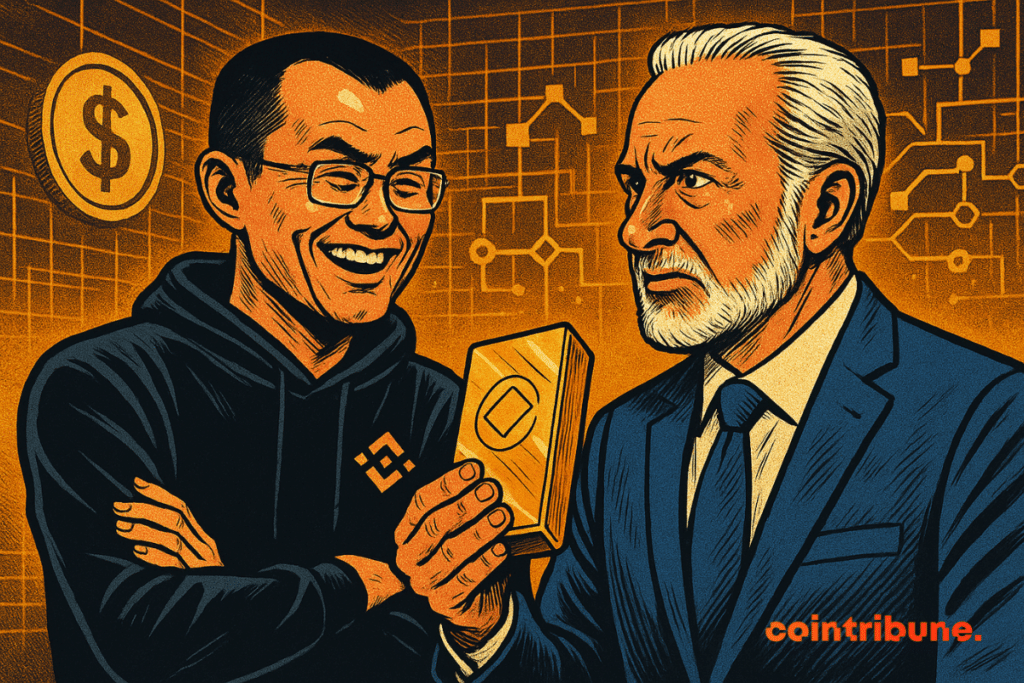CZ Challenges the Credibility of Peter Schiff’s Tokenized Gold Project
CZ, former CEO of Binance, criticizes Peter Schiff’s tokenized gold project by calling it a crypto asset based on trust rather than proof. According to him, tokenization does not make gold truly on-chain and introduces dependence on intermediaries. This remark reignites the debate between two visions: Bitcoin’s verifiable transparency and the traditional value of now-digitized gold.

In Brief
- CZ criticizes Peter Schiff’s tokenized gold, deeming it dependent on human trust
- Schiff defends his token backed by physical gold and predicts Bitcoin’s collapse in favor of a return to the metal
- The debate opposes two irreconcilable visions: Bitcoin’s on-chain transparency versus the traditional promise of tokenized gold.
Tokenized gold remains a promise asset
Peter Schiff envisions a crypto token backed by physical gold. The user buys via an app, stores it in a vault, transfers ownership on the blockchain, and, if desired, redeems the metal. The pitch is appealing due to its apparent simplicity.
But CZ highlights the blind spot. Between the app click and the real gold stands a custodian. A guardian, a company, contracts. In short, human trust. And a potentially long timeline in crisis situations.
Tokenization does not eliminate frictions. It merely shifts them: delayed redemptions, management changes, legal constraints, geopolitical risks. What happens “during a war,” questions CZ on X, if the issuer suspends deliveries? The blockchain records promises, not bullion.
To gain credibility, such a product must multiply safeguards. Proofs of allocation, bar numbers, independent audits, regular publication of stocks, executable redemption rights, and fee caps. Otherwise, on-chain gold is just a modern IOU.
Schiff predicts zero for Bitcoin and the end of the dollar
In substance, Peter Schiff does not waver. For him, Bitcoin has “no intrinsic value” and will end at “zero.” He sees it as a gigantic pump-and-dump, fueled by early exiters and the enthusiasm of latecomers.
His macro scenario is just as sharp. He announces a sovereign debt crisis more severe than 2008, hyperinflation, a Treasury crash, and gold far beyond $4,000 an ounce. End point: the dollar’s dominance as reserve currency would come to an end.
The logical follow-up, according to him, is a “re-goldification” of the system. Central banks sell Treasury bonds, accumulate metal, initiate a monetary reset like the 1970s post-Nixon. In this narrative, the gold token is not a gadget: it is the bridge between vault and daily payments.
One sensitive point remains. If his forecast about the flagship crypto proves wrong or simply too late, the opportunity cost for savers will be real. The “intrinsic” argument weighs less in markets governed by liquidity, collateral demand, and financial programmability.
The gold market signal and the battle of models
The timing is not accidental. Gold just took a brutal plunge, wiping out about $2,500 trillion in market capitalization in 24 hours according to some estimates, with an 8% drop over two days, its worst fall since 2013. More than the total bitcoin value in circulation.
For crypto proponents, this shock tells a different story. Even the “risk-free” asset is not immune to macro volatility. In this context, a gold token, itself subject to the custodian’s liquidity, does not negate variability. It wraps it in a digital veneer.
Conversely, Schiff’s supporters see it as a simple hiccup: if the dollar era cracks, gold would regain its anchor role. Tokenization then becomes an adoption rail, with gold-linked debit cards, cross-border settlements, and simplified inheritance, despite the limits of a model that CZ, not without irony, calls an asset. The dream of a modernized standard.
To decide, one must return to the core of the dispute: proof vs promise. Bitcoin exposes everything on-chain: supply, transfers, finality, immutable rules. Tokenized gold requires adding layers of trust and human audit. Both visions can coexist, but they do not serve the same needs.
Maximize your Cointribune experience with our "Read to Earn" program! For every article you read, earn points and access exclusive rewards. Sign up now and start earning benefits.
Enseignante et ingénieure IT, Lydie découvre le Bitcoin en 2022 et plonge dans l’univers des cryptomonnaies. Elle vulgarise des sujets complexes, décrypte les enjeux du Web3 et défend une vision d’un futur numérique ouvert, inclusif et décentralisé.
The views, thoughts, and opinions expressed in this article belong solely to the author, and should not be taken as investment advice. Do your own research before taking any investment decisions.